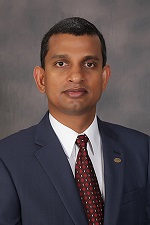Ultrashort Pulse Laser Diagnostics for Chemically Reacting Flows
Hosted By: Laser Systems Technical Group
14 October 2022 13:00 - 14:00
Eastern Time (US & Canada) (UTC -05:00)Advances in ultrashort pulse laser diagnostics have enabled non-intrusive, high-speed, multi-dimensional imaging of chemical species and flow structures in fundamental flames and plasmas to gas turbine combustors and hypersonic flight systems. Following the initial demonstration of femtosecond two-photon laser-induced fluorescence (fs-TPLIF) of H atoms a decade ago, Dr. Waruna Kulatilaka’s group and associated teams have made significant advances in related developments and practical implementations. In particular, fs laser methods have enabled interference-free, kHz-rate imaging of atomic species such as H, O, and N, and molecules such as OH, NO, CO, and O2 in gas-phase flows. Similar fluorescence methods using inert tracers such as Kr and Xe have also enabled imaging flow structures and turbulent mixing, and scalar fields such as temperature.
In this webinar hosted by the Laser Systems Technical Group, Dr. Kulatilaka will highlight several major milestones in ultrashort pulse laser imaging in the last decade, namely, interference-free fs-TPLIF detection of highly reactive atoms, simultaneous excitation/detection of multiple chemical species using a single femtosecond laser pulse, and recent advances towards high-pressure high-temperature imaging applications. Also outlined are the challenges and opportunities in the widespread implementation of these diagnostics for reacting-flow research where critical model-validation data sets can revolutionize the development of next-generation computational models.
Subject Matter Level: Intermediate - Assumes basic knowledge of the topic
What You Will Learn:
• Gas-phase fluorescence spectroscopy using ultrashort laser pulses
• Applications of femtosecond imaging methods for chemically reacting flows
• Opportunities and challenges in laser imaging diagnostics in harsh environments such as gas turbine engines and hypersonic flight systems development
Who Should Attend:
• Students, postdocs, and young professionals
• Experienced researchers in gas-phase spectroscopy and laser diagnostics
About the Presenter: Waruna Kulatilaka from Texas A&M University
 Waruna Kulatilaka is a Professor and Morris E. Foster Faculty Fellow I in Mechanical Eng with a joint courtesy appointment in Aerospace Eng at Texas A&M University. Kulatilaka is a pioneer in ultrashort-pulse laser diagnostics in flames and plasmas with specific applications in combustion, propulsion, energetics, materials testing, and hypersonic flows. In recent years, he and associated teams have spearheaded the development of femtosecond multi-photon fluorescence imaging methods for chemical speciation and flow diagnostics. Dr. Kulatilaka obtained his Ph.D. from Purdue University, completed a postdoctoral fellowship at Sandia CRF, then worked as a Senior Research Scientist/On-Site Contractor at the Air Force Research Laboratory at WPAFB before joining Texas A&M in 2014. Kulatilaka is active in multiple professional organizations, including ASME (Fellow), AIAA (Associate Fellow), Optica (Senior Member & Associate Editor of Applied Optics), and the Combustion Institute.
Waruna Kulatilaka is a Professor and Morris E. Foster Faculty Fellow I in Mechanical Eng with a joint courtesy appointment in Aerospace Eng at Texas A&M University. Kulatilaka is a pioneer in ultrashort-pulse laser diagnostics in flames and plasmas with specific applications in combustion, propulsion, energetics, materials testing, and hypersonic flows. In recent years, he and associated teams have spearheaded the development of femtosecond multi-photon fluorescence imaging methods for chemical speciation and flow diagnostics. Dr. Kulatilaka obtained his Ph.D. from Purdue University, completed a postdoctoral fellowship at Sandia CRF, then worked as a Senior Research Scientist/On-Site Contractor at the Air Force Research Laboratory at WPAFB before joining Texas A&M in 2014. Kulatilaka is active in multiple professional organizations, including ASME (Fellow), AIAA (Associate Fellow), Optica (Senior Member & Associate Editor of Applied Optics), and the Combustion Institute.
